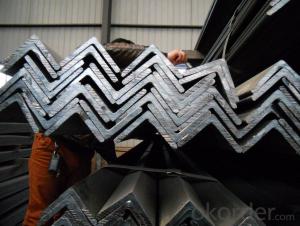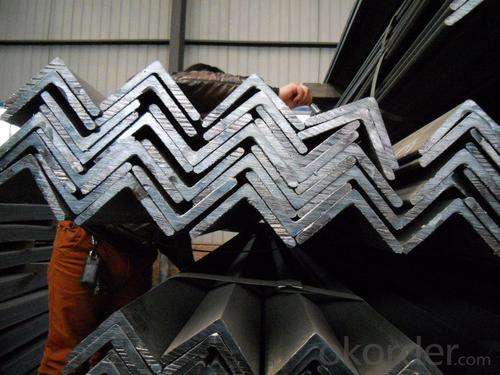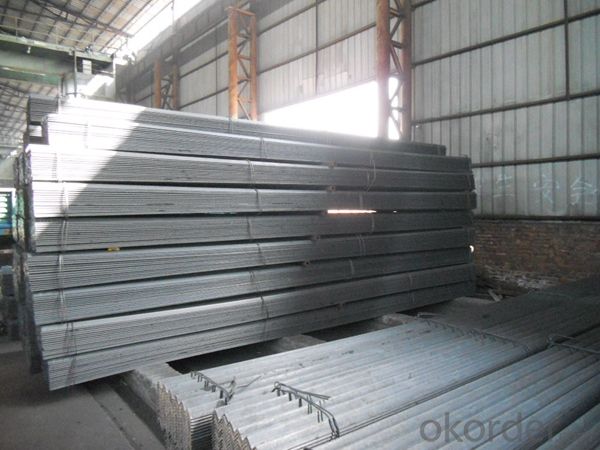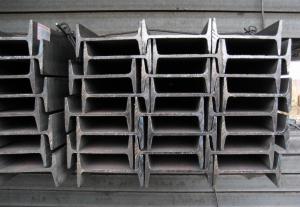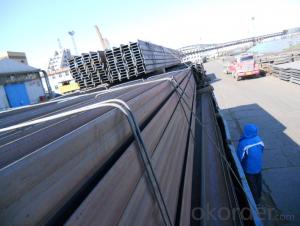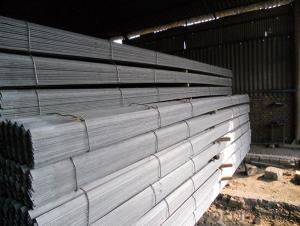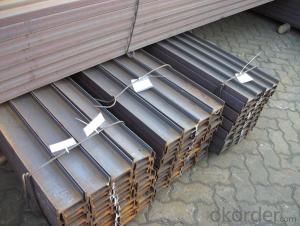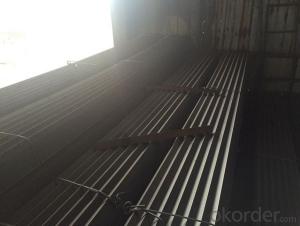High Quality Hot Rolled Equal Angle Steel Bars for Strcuture
- Loading Port:
- Tianjin
- Payment Terms:
- TT OR LC
- Min Order Qty:
- 25 m.t.
- Supply Capability:
- 200000 m.t./month
OKorder Service Pledge
OKorder Financial Service
You Might Also Like
Product Description:
OKorder is offering high quality High Quality Hot Rolled Equal Angle Steel Bars for Strcuture at great prices with worldwide shipping. Our supplier is a world-class manufacturer of steel, with our products utilized the world over. OKorder annually supplies products to European, North American and Asian markets. We provide quotations within 24 hours of receiving an inquiry and guarantee competitive prices.
Product Applications:
High Quality Hot Rolled Equal Angle Steel Bars for Strcuture are ideal for structural applications and are widely used in the construction of buildings and bridges, and the manufacturing, petrochemical, and transportation industries.
1. Supporting members, most commonly in the house raising industry to strengthen timber bears under houses. Transmission line towers, etc
2. Prefabricated structure
3. Medium scale bridges
4. It is widely used in various building structures and engineering structures such as roof beams, bridges, transmission towers, hoisting machinery and transport machinery, ships, industrial furnaces, reaction tower, container frame and warehouse etc.
Product Advantages:
High Quality Hot Rolled Equal Angle Steel Bars for Constrcution are durable, strong, and resist corrosion.
Main Product Features:
· Premium quality
· Prompt delivery & seaworthy packing (30 days after receiving deposit)
· Corrosion resistance
· Can be recycled and reused
· Mill test certification
· Professional Service
· Competitive pricing
Product Specifications:
1. Invoicing on theoretical weight or actual weight as customer request
2. Standard: EN10025, GB Standard, ASTM
3. Grade: Q235B, Q345B, SS400, ASTM A36, S235JR, S275JR
4.Sizes:
EQUAL ANGLES SIZES | |||
a(mm) | a1(mm) | thickness(mm) | length |
25 | 25 | 2.5---3.0 | 6M/12M |
30 | 30 | 2.5---4.0 | 6M/12M |
38 | 38 | 2.5 | 6M/12M |
38 | 38 | 3.0---5.0 | 6M/12M |
40 | 40 | 3.0---6.0 | 6M/12M |
50 | 50 | 3 | 6M/12M |
50 | 50 | 3.7---6.0 | 6M/9M/12M |
60 | 60 | 5.0---6.0 | 6M/9M/12M |
63 | 63 | 6.0---8.0 | 6M/9M/12M |
65 | 65 | 5.0---8.0 | 6M/9M/12M |
70 | 70 | 6.0---7.0 | 6M/9M/12M |
75 | 75 | 5.0---10.0 | 6M/9M/12M |
80 | 80 | 6.0---10.0 | 6M/9M/12M |
90 | 90 | 6.0---10.0 | 6M/9M/12M |
100 | 100 | 6.0---12.0 | 6M/9M/12M |
120 | 120 | 8.0-12.0 | 6M/9M/12M |
125 | 125 | 8.0---12.0 | 6M/9M/12M |
130 | 130 | 9.0-12.0 | 6M/9M/12M |
140 | 140 | 10.0-16.0 | 6M/9M/12M |
150 | 150 | 10---15 | 6M/9M/12M |
160 | 160 | 10---16 | 6M/9M/12M |
180 | 180 | 12---18 | 6M/9M/12M |
200 | 200 | 14---20 | 6M/9M/12M |
5. Material details:
Alloy No | Grade | Element (%) | |||||
C | Mn | S | P | Si | |||
Q235 | B | 0.12—0.20 | 0.3—0.7 | ≤0.045 | ≤0.045 | ≤0.3 | |
Alloy No | Grade | Yielding strength point( Mpa) | |||||
Thickness (mm) | |||||||
≤16 | >16--40 | >40--60 | >60--100 | ||||
≥ | |||||||
Q235 | B | 235 | 225 | 215 | 205 | ||
Alloy No | Grade | Tensile strength (Mpa) | Elongation after fracture (%) | ||||
Thickness (mm) | |||||||
≤16 | >16--40 | >40--60 | >60--100 | ||||
≥ | |||||||
Q235 | B | 375--500 | 26 | 25 | 24 | 23 | |
FAQ:
Q1: Why buy Materials & Equipment from OKorder.com?
A1: All products offered byOKorder.com are carefully selected from China's most reliable manufacturing enterprises. Through its ISO certifications, OKorder.com adheres to the highest standards and a commitment to supply chain safety and customer satisfaction.
Q2: How do we guarantee the quality of our products?
A2: We have established an advanced quality management system which conducts strict quality tests at every step, from raw materials to the final product. At the same time, we provide extensive follow-up service assurances as required.
Q3: How soon can we receive the product after purchase?
A3: Within three days of placing an order, we will begin production. The specific shipping date is dependent upon international and government factors, but is typically 7 to 10 workdays.
Q4: What makes stainless steel stainless?
A4: Stainless steel must contain at least 10.5 % chromium. It is this element that reacts with the oxygen in the air to form a complex chrome-oxide surface layer that is invisible but strong enough to prevent further oxygen from "staining" (rusting) the surface. Higher levels of chromium and the addition of other alloying elements such as nickel and molybdenum enhance this surface layer and improve the corrosion resistance of the stainless material.
Q5: Can stainless steel rust?
A5: Stainless does not "rust" as you think of regular steel rusting with a red oxide on the surface that flakes off. If you see red rust it is probably due to some iron particles that have contaminated the surface of the stainless steel and it is these iron particles that are rusting. Look at the source of the rusting and see if you can remove it from the surface.
Images:
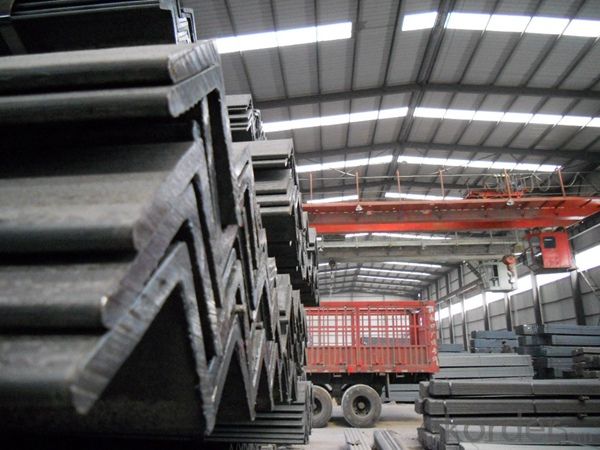
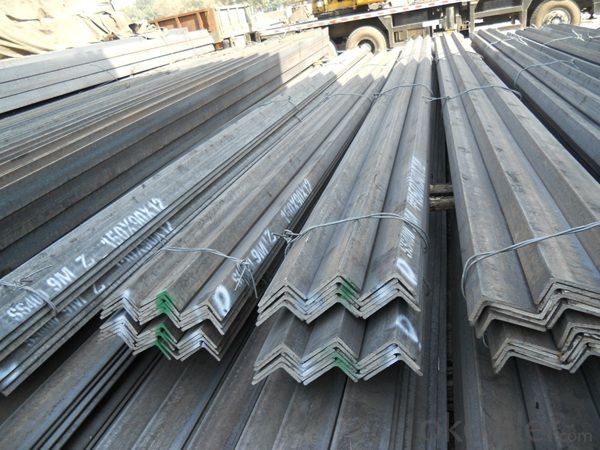
- Q: What is the difference between GB and non - marking of I-beam?
- The difference between the national standard and non - standard I-beam is with the theory of similar size, such as the angle of 50*50*5, GB thickness is very close to 5, such as the thickness of Maanshan Iron and steel, is only reached 4.5, even more thin, so the difference between non standard, GB, is not the same thickness, the weight is not the same, when purchasing can meet the design requirements can choose the appropriate standard, this will save money, because the non-standard, much cheaper than gb.
- Q: Can steel I-beams be used in mezzanine or elevated platform construction?
- Yes, steel I-beams can be used in mezzanine or elevated platform construction. They provide structural support and stability, making them a common choice for such applications.
- Q: What are the cost implications of using steel I-beams in construction?
- The cost implications of using steel I-beams in construction can vary depending on several factors. Firstly, the initial cost of steel I-beams is generally higher compared to alternative building materials such as wood or concrete. This is because steel is a premium material known for its strength, durability, and load-bearing capabilities, which makes it a preferred choice for supporting heavy structures. However, it is important to note that steel I-beams tend to have a longer lifespan and require less maintenance compared to other materials, which can contribute to cost savings in the long run. Additionally, the cost of using steel I-beams in construction is influenced by the size and weight of the beams required for the project. Larger and heavier beams will naturally cost more due to the increased amount of steel needed and the associated transportation and handling costs. Another cost consideration is the installation process. Steel I-beams require specialized equipment and skilled labor for proper installation, which can add to the overall project expenses. However, the speed and ease of installation can offset these costs by reducing construction time and labor hours. Furthermore, steel is a versatile material that can be easily recycled. This contributes to the sustainability aspect of using steel I-beams and can result in potential cost savings through recycling incentives or reduced waste disposal fees. Overall, while the upfront cost of using steel I-beams in construction may be higher, the long-term benefits such as durability, reduced maintenance, and potential sustainability advantages can outweigh the initial investment. It is important to carefully evaluate the specific project requirements, structural needs, and budget constraints to determine the most cost-effective solution.
- Q: Can steel I-beams be used in bridge or overpass construction?
- Certainly, bridge or overpass construction can incorporate steel I-beams. These beams are widely utilized in such projects owing to their exceptional strength, durability, and versatility. Their ability to bear heavy loads and provide structural stability makes them highly sought-after for numerous civil engineering endeavors. Customization and optimization of bridge or overpass designs are made possible by the ability to tailor and fabricate steel I-beams to meet specific project requirements. Moreover, they possess resistance to corrosion and can withstand severe weather conditions, rendering them suitable for long-term utilization in outdoor structures. All things considered, steel I-beams prove to be a dependable and efficient choice for bridge and overpass construction.
- Q: Can steel I-beams be used for commercial renovations?
- Yes, steel I-beams can be used for commercial renovations. Steel I-beams are commonly used in construction due to their strength and durability. They can support heavy loads and provide structural stability, making them suitable for various commercial applications such as reinforcing existing structures, creating open floor plans, or adding additional floors. Additionally, steel I-beams can be easily customized to fit specific project requirements and are often preferred over other materials for their cost-effectiveness and versatility.
- Q: What is the maximum span that steel I-beams can support without additional support?
- The maximum span that steel I-beams can support without additional support depends on various factors such as the size and type of the I-beam, the load applied, and the desired level of deflection. It is recommended to consult structural engineers or reference load tables to determine the specific maximum span for a given situation.
- Q: Can steel I-beams be used in schools or educational facilities?
- Schools and educational facilities can indeed utilize steel I-beams. These beams are widely employed in the construction industry because of their robustness, endurance, and adaptability. By lending structural support to buildings, they prove to be ideal for educational establishments where safety takes precedence. Steel I-beams exhibit remarkable resistance to heavy loads and provide the necessary stability, making them invaluable in schools featuring multiple floors and expansive areas. Moreover, their utilization allows for greater flexibility in design, as they can span longer distances without requiring supplementary support columns, thereby creating open and commodious learning environments. All in all, steel I-beams represent a dependable and pragmatic choice for construction within schools and educational facilities.
- Q: Can steel I-beams be used in entertainment or stadium construction?
- Yes, steel I-beams can be used in entertainment or stadium construction. They are commonly used in the construction of large venues like stadiums due to their high strength and load-bearing capabilities. Steel I-beams provide structural support and can withstand heavy loads and vibrations, making them suitable for constructing grandstands, roofs, and other essential components of such structures.
- Q: What are the different types of coatings available for Steel I-Beams?
- There are several different types of coatings available for steel I-beams, each offering different benefits and protection against various environmental factors. Some of the commonly used coatings for steel I-beams include: 1. Galvanized Coating: This is one of the most popular coatings for steel I-beams. It involves applying a layer of zinc to the surface of the beam through a hot-dip galvanizing process. Galvanized coatings provide excellent corrosion resistance, making them suitable for outdoor applications where the beams are exposed to moisture, humidity, and harsh weather conditions. 2. Epoxy Coating: Epoxy coatings are commonly used for steel I-beams that will be exposed to aggressive environments such as chemical plants or marine environments. These coatings are highly resistant to chemicals, abrasion, and impact. They provide a smooth, durable finish that helps protect the beams from corrosion and also enhances their aesthetic appeal. 3. Powder Coating: Powder coating is a popular choice for steel I-beams in indoor applications or areas with minimal exposure to moisture and chemicals. It involves applying a dry powder to the surface of the beam, which is then cured under heat to create a hard, durable coating. Powder coatings offer excellent resistance to chipping, scratching, and fading, and are available in a wide range of colors, allowing for customization and branding opportunities. 4. Paint Coating: Paint coatings are commonly used for steel I-beams in indoor applications or areas with minimal exposure to moisture and harsh environments. These coatings provide basic protection against corrosion and can be customized with different colors and finishes. However, paint coatings may require periodic maintenance and touch-ups to ensure continued protection. 5. Fire-Resistant Coating: Fire-resistant coatings are applied to steel I-beams to enhance their fire resistance. These coatings are designed to prevent or delay the spread of flames and heat, providing additional time for evacuation and firefighting efforts during a fire incident. It is important to consider the specific requirements of the application and the environment in which the steel I-beams will be used when selecting a coating. Consulting with a coating specialist or engineer can help determine the most suitable coating option for your specific needs.
- Q: Are there any maintenance requirements for steel I-beams?
- Yes, there are maintenance requirements for steel I-beams. While steel is a durable material, it is still susceptible to certain factors that can affect its integrity over time. Regular maintenance is necessary to ensure the longevity and safety of steel I-beams. One important maintenance requirement for steel I-beams is inspection. Regular visual inspections should be conducted to identify any signs of damage or deterioration. This includes checking for cracks, corrosion, or any other structural issues that may compromise the strength of the I-beams. Inspections can help identify potential problems early on and allow for timely repairs or replacements. Another maintenance requirement is cleaning. Steel I-beams should be cleaned periodically to remove dirt, debris, or any corrosive substances that may have accumulated on the surface. Cleaning can be done using a mild detergent and water, or specialized cleaning solutions depending on the level of dirt or corrosion present. Regular cleaning helps prevent the buildup of contaminants that can accelerate corrosion or weaken the steel. Additionally, it is important to address any identified issues promptly. If any cracks, corrosion, or damage are found during inspections, it is crucial to take immediate action to repair or replace the affected I-beams. Ignoring or delaying repairs can lead to further deterioration and compromise the structural integrity of the steel beams. Furthermore, in some cases, steel I-beams may require protective coatings or paints to prevent corrosion. These coatings act as a barrier between the steel and its environment, preventing moisture or other corrosive elements from reaching the surface. The type and frequency of coating application may vary depending on the specific conditions and requirements of the application. In conclusion, regular inspection, cleaning, and prompt repairs or replacements are essential maintenance requirements for steel I-beams. By following these maintenance practices, the longevity and performance of steel I-beams can be ensured, ultimately contributing to the safety and durability of structures they support.
Send your message to us
High Quality Hot Rolled Equal Angle Steel Bars for Strcuture
- Loading Port:
- Tianjin
- Payment Terms:
- TT OR LC
- Min Order Qty:
- 25 m.t.
- Supply Capability:
- 200000 m.t./month
OKorder Service Pledge
OKorder Financial Service
Similar products
Hot products
Hot Searches
Related keywords
